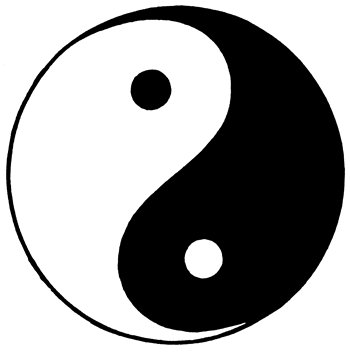There is a widely shared misconception that a good relationship has no conflict and no suffering, and that the purpose and goal of a good relationship is the elimination of both. Unfortunately, what happens with this line of thinking is people end up eliminating the dynamic energy that inspires love. What then follows, because no one can eradicate conflict or suffering, eventually they drive each other from their lives or love from the relationship. Dynamic and egalitarian relationships have a respectful and active tension that keep them growing. Neither side seeks to correct or change the other. Nor do they slip into a bored and distant complacency. Rather they are complementary opposites that reveal other and create something new and unique.
The Taiji symbol illustrated below is the "supreme ultimate" at illustrating this in theory. It forms a great philosophical foundation for understanding unconditional mutual respect in a relationship. With "unconditional mutual respect" as a definition of love, one could say yin "loves" yang and yang "loves" yin. People in relationships appear to function differently than the pure energy exchange that is defined by the movement between the positive and negative poles of a battery. What if instead of fighting to correct each other, we corrected HOW we fight each other?

Relationships are naturally fraught with challenges and discomfort. The closer the relationship, the greater the potential for challenge and discomfort. A sigh from a spouse can land like a crack of lightning, while the sigh of a stranger like a breeze. A real relationship is both good and bad. A great relationship is defined by how you can handle both good and bad while maintaining a connection to each other. It is comprised of two persons who are committed to enjoying the good times and creating a mutually beneficial outcome from the inevitable conflict and suffering.
Most people naturally want the benefits of being in a good relationship, but they don’t want the suffering that comes with it. The problem is complicated by how people naturally handle this suffering. Most react to it in a way that is intrinsically opposed to love. You cannot love someone and blame and punish them at the same time. You can do one or the other, but not both. Nor can you love and resent them, neglect them, shout at them, cut them off with silence, attack them, or avoid them. These are expressions of harm that naturally appear when love ends. You can either resent or forgive, honor or blame, respect or punish, love or harm.
What can we do? How can we have a relationship, especially a loving one, that is healthy and mutually beneficial? It begins with acceptance of our nature and setting clear limits in favor of maintaining concurrent mutual respect. For where there is unconditional concurrent mutual respect between two people, there can be no harm, and love can flourish and nourish both people.
Concurrent Mutual Respect
Accountability is grounded in respect and remorse. For instance, if you hurt someone, rather than offer up blame or excuses, you can offer up accountability such as “I see that I messed up. It is painful to me and it matters. I will work to improve my actions.”
Neither party has the right to harm the other through either abuse or neglect, no matter what. This is a sacred agreement that is never to be violated. Unless the person who harms is accountable to this, demonstrates remorse, and devotes themselves to dismantling the compulsion that made it acceptable to harm someone they love, it will repeat. If it happens once and is excused, it will happen again. It is just a matter of time. The only way to stop this pattern is to commit to the following four principles:
1 Always Adhere to Concurrent Unconditional Mutual Respect. We always watch out for each other’s well-being. This means always, not sometimes, or when I feel like it and it’s convenient to me, or if you’re being nice to me. This translates to respect in real-time, under all circumstances, given by both parties to each other and within themselves.
Conflict is necessary — harm is not.
2 Never harm the other person. We never harm each other, no matter what. You are either an ally or an enemy, not both. Harm violates the first commitment. This is a critical and challenging principle. The history of humanity is the history of harm. The debate of who has the right to harm and when forms the core of the conflicts we face today. No one has the right to harm, but every person who harms believes they have the right to. They don't. No one does. Harm has no place in a relationship founded in concurrent mutual respect. In fact, harm only appears in the absence of concurrent mutual respect. When it comes to matters of harm, I believe it is best to function like a well defined guardrail.
3 Interrupt compulsive patterns. If someone’s nature gets the best of them and they react with an attack or an avoid, they must stop this course of action immediately and set about making amends that include training to stop the pattern. Adhering to the interruption of compulsive patterns honors the first commitment. Compulsions are hard to arrest, especially if you want to arrest them. No blame. If one kicks in, accept it and redirect back to your commitment, clean it up. Be vigilant.
4 Don’t rationalize bad behavior. It is never okay to rationalize or justify the harm. “I’m sorry, I had a bad day.” is not okay. This violates the first commitment.
By mutually respecting those with whom we have relationships, we strengthen our character, develop our integrity and build trust with one another. We may not be able to end the suffering in our lives, but we can move forward knowing that those with whom we have close intimate relationships truly have our best interests at heart and that we give them the same in return. Ideally, with the threat of harm removed from the relationship, energy can flow and love can naturally grow.

